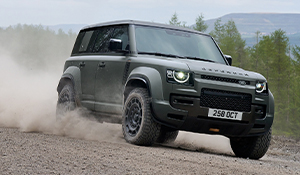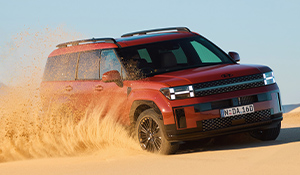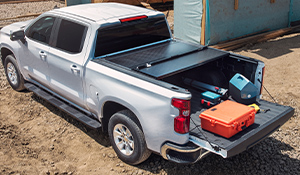1954 107 LWB Land Rover Series I
Designed merely as a stopgap model, to circumvent shortages of steel, it was built mainly of aluminium alloy and aimed to tap in to a worldwide demand from farmers for mechanisation. Rover noted the success being enjoyed by Ferguson tractors and the Land Rover was conceived as a robust 4x4 agricultural vehicle.
From the outset the Land Rover was to have a limited life, until a medium sized Rover car could be built and production returned to pre-war levels. Accordingly, the Land Rover was built as cheaply as possible, incorporating every possible Rover car component. As there was to be minimal investment in tooling, panels were kept flat so they could be formed by hand; a box section chassis was used consisting of strips of flat steel simply welded together. A 1.6-litre Rover engine was used, with a four-speed gearbox from the Rover P3 and a new 2-speed transfer case.
Perhaps unexpectedly, the Land Rover became a hit and Rover was forced to re-evaluate the future of their off-road workhorse. Known deficiencies could no longer be overlooked, as customers wanted to expand the capabilities of the Land Rover.
The two major complaints were the minimal carrying capacity of the vehicle and the lack of power.
Bigger Land Rovers
Despite the constraints of materials, budget and availability of compatible components, Land Rover engineers did an admirable job in improving the Land Rover after the realisation hit that the success of the Land Rover was such that it was no longer a limited life stopgap!
Admittedly little changed in the first three years, but important changes were made to the springs, clutch, flywheel and brake linings in 1950, with the introduction of a dog clutch making it possible to select high range 2WD to provide better fuel economy. The first major mechanical change was the introduction in 1951 of the 2.0-litre petrol engine. This unit actually produced minimal additional power bit did deliver a substantial increase in torque at lower engine speeds.
More importantly for many customers was the arrival of bigger Land Rovers.
In 1954 the 80-inch wheelbase was replaced by an 86-inch wheelbase model, and a 107-inch "Pick Up " version was introduced. In the 86-inch model an extra 6-inches were added to the load area within the wheelbase, and another 3 inches were added to the rear overhang, providing a net load space gain of 25 percent.
107-inch Land Rover
Archives indicate that as early as August 1950 a prototype of the 107-inch Land Rover existed. The 1954 107 Land Rover offered a 50 percent increase in load space, with the load area now 57 inches wide and 72 inches long. The load area was now a lengthy 41 inches longer than that of the original Series I of 1948. The 107-inch vehicle weighed considerably more with an unladen weight of 1,375kg, compared to 1,176kg, and its official payload was three persons and 680kg.
It was powered by the 1,997cc (2.0-litre) petrol engine, with overhead-inlet and side exhaust valves, mated to a four-speed constant mesh gearbox in which third and top ratios had synchromesh. The drive passed through a two-speed transfer case. Formerly the Land Rover had permanent drive to the front wheels, with a free wheel to prevent transmission wind-up on hard surfaced roads. Dispensing with this enabled the 107 to be driven as a two-wheel (rear) drive on the road in high range. Four-wheel drive was engaged by pressing a knob control. 4x4 was automatically engaged when low range gears were selected. This provided the Land Rover with eight forward gears and an overall ratio spread of 5.396 to 40.676 to 1.
The 107-inch wheelbase chassis was provided with a standard body of just over 6 feet internal length which, carried a nominal 10 cwt load, providing equal weight distribution on the axles.
Offered initially only as a Pick Up, both the 88 and 107 gained a number of modest comforts. There was a newly designed fascia with larger instruments, a full-width parcel shelf, improved rubber sprung seats and a De Lux model 107 was offered that even included head lining, door trims, floor covering and heater and demister unit.
The gear lever operation was also improved and the floor pedal angle was adjusted. Land Rover marketing also proclaimed that ride and handling was improved on the LWB model as the longer prop-shafts permitted more vertical rear wheel movement.
Topping off the new look Land Rovers was the choice for the first time of additional paint colours, with the traditional dark green colour joined by the choice of grey and blue alternatives.
A year later glass replaced Perspex side windows, while bigger brakes were fitted, allowing the 107-inch Land Rover payload to be raised to 15 cwt.
The new brakes were Girling hydraulic two leading shoe type at the front and leading and trailing shoe at the rear. They were 11-inches in diameter and 2.25 inches wide. The handbrake operated on the transfer case output shaft. Suspension was semi elliptic springs with Monroe telescopic shock absorbers and steering was Burman worm and nut.
There was a 10 gallon fuel tank that provided a range of approximately 180 miles, with an average unladen fuel consumption of 19.85 mpg at 34 mph. Official acceleration figures were 0-30mph in 9.4 seconds and 0-40 mph achieved in 20 seconds.
While the 107 looked like a new Land Rover, it used maximum panels found on existing Land Rovers, while others, such as he rear side doors were created with the minimum of new pressings required. Internally there was seating for three people in the front, three on the back seats and four facing inwards on additional seats fitted to the rear wheel boxes. With these seats removed, the whole body was available for load carrying.
The 107-inch Land Rover actually sold quite well and remained largely unchanged for a further two years.
Also using the 107-inch platform was the Land Rover Station wagon, with just 239 built for the UK market. Between 1954 and 1958 some 27,346 107-inch Land Rovers were built.
In 1956 Land Rover stretched t he wheelbases of the 86 and 107-inch models by 2 inches to become 88 and 109 inches respectively. They were referred to as the Regular and Long models. The 86-inch and 107-inch models were immediately suspended, with the exception of the 107-inch Station wagon that remained in production until September 1958. Why the extra 2 inches were added to the bulkhead was at first a mystery, but all became clear the following year when Land Rover's first diesel engine was introduced. Without those two extra inches the new diesel engine could not have been accommodated. The diesel was never fitted to the 107 Station Wagon, which was to become the last Series I in production.
107-inch Land Rover Production
1954 - 3,820
1955 - 8,690
1956 - 7,837
1956 (107 Station Wagons) - 1,266
1957 - 2,420
1958 - 3,315















